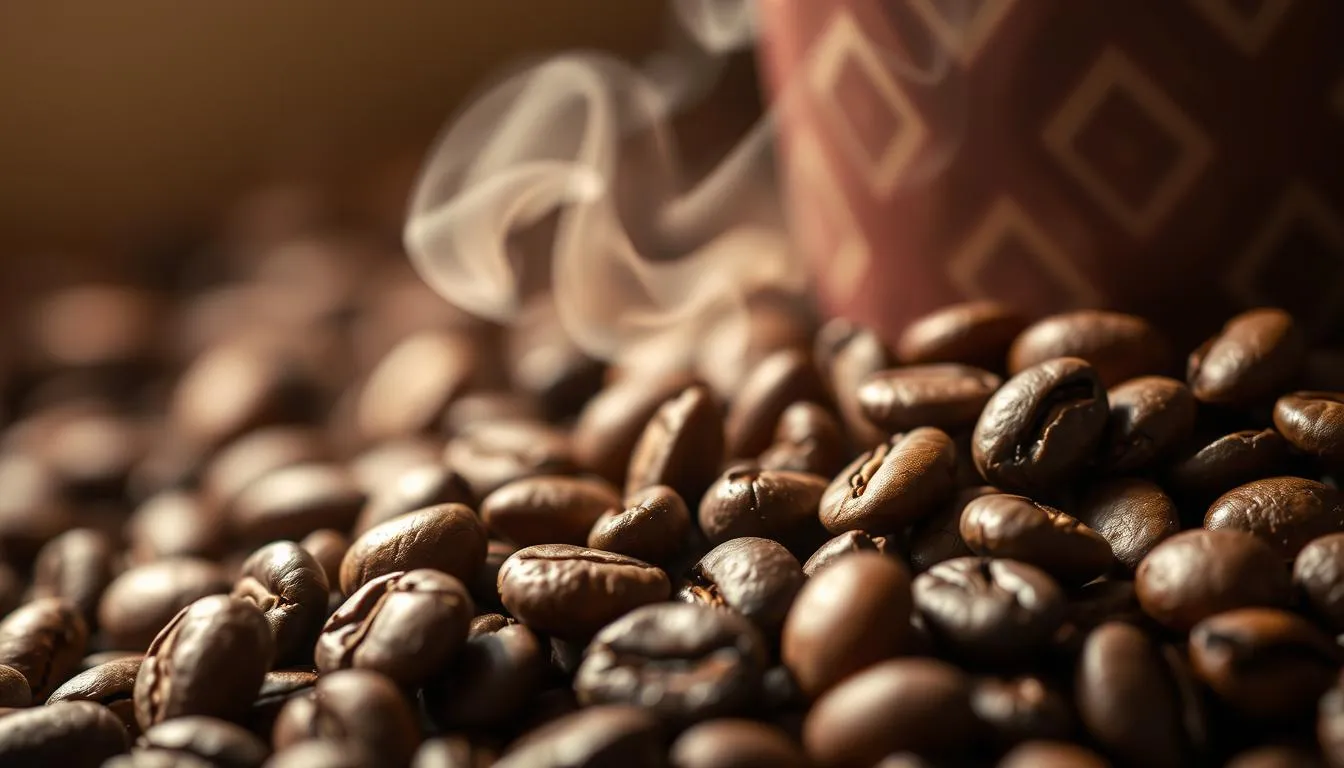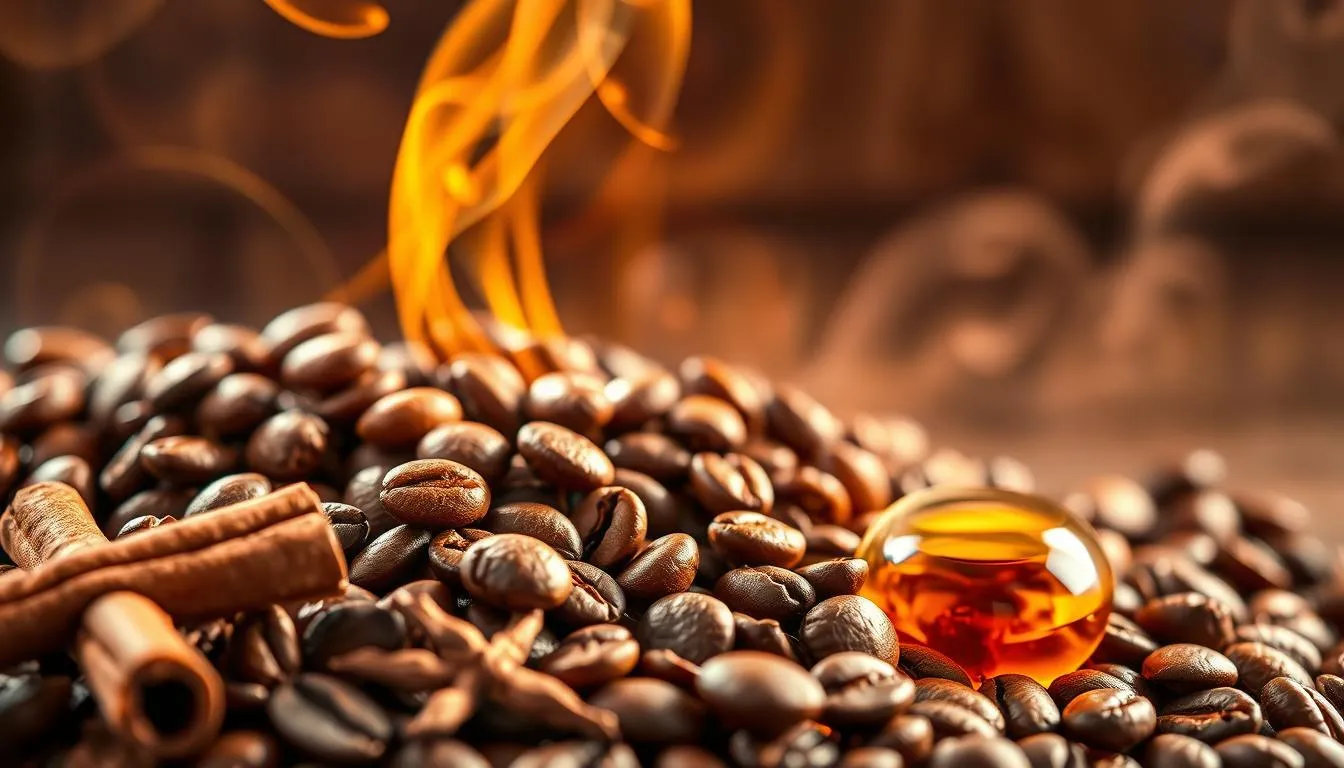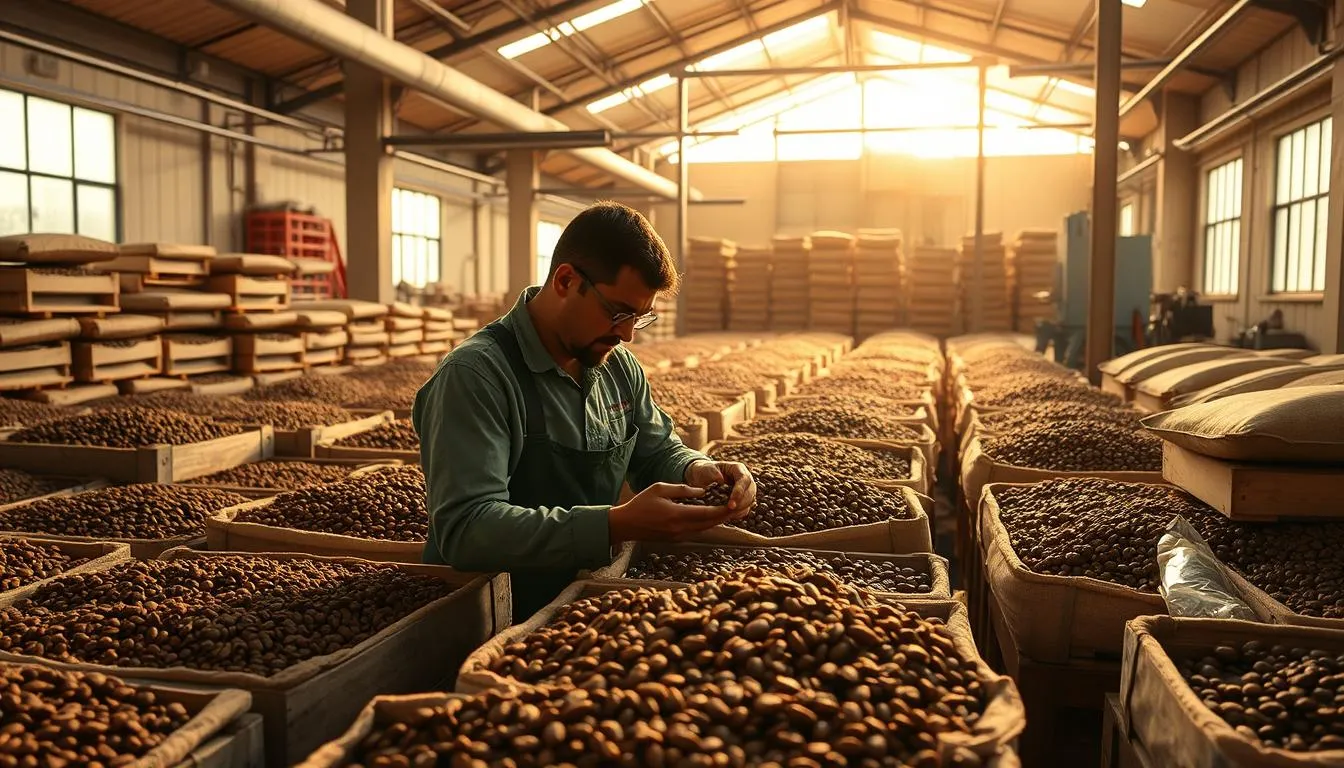Flavored coffee beans have revolutionized the coffee industry, offering exciting taste variations beyond traditional black coffee. From classic vanilla and rich hazelnut to bold caramel and exotic fruit infusions, the possibilities are endless. But how are these flavors created? It all comes down to coffee flavoring techniques and aroma compounds that enhance the natural depth of coffee beans.
This guide explores the history, manufacturing process, science behind taste, and quality control involved in crafting high-quality flavored coffee beans.
👉 So get barista-level brewing at home with the 🛒 Ninja DualBrew 12-Cup Drip Coffee Maker

Key Takeaways
- Flavored coffee beans are made by applying flavoring agents to the beans
- Coffee flavoring is a complex process that involves a deep understanding of the science behind the taste
- Aroma compounds play a crucial role in creating the unique flavors of flavored coffee
- The type of coffee beans used can affect the final flavor of the coffee
- Flavored coffee beans offer a wide range of flavors to suit every taste preference
The History of Flavored Coffee Beans Through Time
Flavored coffee beans have a long history, with many cultures adding to their evolution. The choice of coffee bean selection has greatly influenced coffee flavors. From ancient times to now, flavoring coffee has changed a lot, thanks to trade, migration, and cultural exchange.
The use of natural flavorings has been common for centuries. Different places have their own ways of flavoring coffee. Some use spices, herbs, and botanicals, while others roast and grind beans to enhance their natural taste.
- Ancient Arabian traders flavored their coffee with cardamom and cinnamon.
- European explorers introduced vanilla and chocolate-infused coffee.
- Modern roasters experiment with innovative flavors, including nut, fruit, and spice infusions.
These changes have made more flavors available and changed how we enjoy coffee. Knowing the history of flavored coffee beans helps us appreciate the variety and complexity of coffee culture. It shows the importance of coffee bean selection and natural flavorings in creating unique coffee experiences.
Choosing the Right Coffee Beans
Coffee production is all about the final flavor. Choosing the right coffee beans is key. The type, origin, and how they’re processed all matter.
Quality control is vital in coffee making. It checks the beans for size, shape, color, and moisture. High-quality beans are needed for great-tasting flavored coffee.
The base coffee bean selection significantly impacts the final flavor. Key factors include:
- Bean Type: Arabica (smooth, mild) or Robusta (bold, strong)
- Origin: Ethiopian, Colombian, Brazilian, or other regional influences
- Processing Method: Washed, natural, or honey-processed for varied flavor profiles
Knowing these factors and focusing on quality control helps. High-quality beans ensure a smooth and balanced flavored coffee experience. This ensures the beans are top-notch for flavoring. And that means your flavored coffee will taste amazing.
The Science of Taste and Aroma in Coffee
Coffee’s unique flavor and aroma come from complex chemical compounds. These compounds, known as aroma compounds, make coffee taste and smell distinct. The art of coffee flavoring is about balancing these compounds for a perfect taste.
When we drink coffee, our brains work hard to understand the flavors. They process the aroma compounds and other chemicals to create the taste we experience. The role of aromatics in taste is key, making the coffee experience richer and more enjoyable.
Several factors affect coffee’s taste and aroma. These include the type of coffee beans, how they’re roasted, and the brewing method. Each factor changes the balance of compounds, leading to different flavors. Knowing the science behind coffee flavoring helps makers create unique and tasty flavors for everyone.
Key aspects of coffee flavoring include:
- Chemical Composition: The natural oils and compounds in coffee beans
- Roasting Process: Light, medium, or dark roasts change flavor absorption
- Brewing Method: Drip, espresso, cold brew, and French press influence taste perception
Understanding these elements helps coffee makers craft unique and high-quality flavored coffee.
How Flavored Coffee Beans Are Made
Making flavored coffee beans involves several steps.
- Bean Selection: High-quality beans are chosen for their ability to absorb flavors.
- Roasting: Beans are roasted to the ideal level before flavor infusion.
- Flavoring Application: Coffee is either sprayed or soaked in flavoring agents.
- Blending & Packaging: Once flavored, beans are blended and packed for freshness.
Both natural and artificial flavors can be used, depending on the coffee’s intended taste.
Natural vs. Artificial Flavoring Agents
The debate on flavored coffee beans is ongoing. Natural flavorings come from fruits, nuts, and spices, giving a unique taste. Artificial flavorings, made in labs, are cheaper and consistent.
Vanilla, hazelnut, and caramel are common natural flavorings. They’re extracted to create a strong flavor for coffee. Artificial flavorings, on the other hand, are made by chemists in labs.
Although artificial flavors are more cost-effective, many coffee lovers prefer the authentic taste of natural ingredients.
Popular Flavored Coffee Bean Varieties
There are many coffee flavoring options, each with its own taste and smell. The coffee production process carefully selects and mixes flavors for the perfect cup. Hazelnut, caramel, and vanilla are some of the most loved flavors.
These tastes come from natural and artificial flavorings added to the beans during coffee production. This makes a tasty and fragrant coffee that many enjoy.

There are also fruity and spicy flavors to try. Your choice of coffee flavoring depends on what you like. So, it’s fun to experiment with different flavors to find your favorite.
The world of flavored coffee beans is vast and exciting. Whether you prefer classic or unique flavors, there’s a perfect one for you.
The Role of Oil-Based Flavorings
Oil-based flavorings are key in making flavored coffee beans. They add a variety of aroma compounds that boost the taste. To keep the quality high, makers follow strict quality control steps. This ensures the final product is consistent and safe.
Flavoring coffee beans with oil-based flavorings requires careful thought. Flavor profile and aroma intensity are very important. They affect how people taste and judge the coffee’s quality. By picking the right oils, makers can create unique flavors that appeal to many.
- Types of flavoring oils: natural, synthetic, and blended oils, each with its own characteristics and applications
- Application methods: spraying, coating, or infusing the coffee beans with flavoring oils to achieve the desired aroma and taste
- Shelf life considerations: proper storage and handling of flavored coffee beans to preserve their aroma and flavor
Understanding oil-based flavorings and quality control is crucial. Coffee makers can then create top-notch flavored coffee beans. These meet the high standards of picky consumers, ensuring quality and safety.
👉 Brew barista-quality espresso anywhere with the 🛒 OutIn Nano Portable Electric Espresso Machine—a self-heating, USB-C powered coffee maker perfect for camping, travel, and on-the-go coffee lovers, compatible with both ground coffee and NS capsules.
Quality Control in Flavored Coffee Production
Ensuring the quality of flavored coffee beans is key for happy customers and a good brand image. Quality checks are done during production to make sure the flavor stays the same. These checks include tasting the flavor, aroma, and overall taste.
Flavored coffee makers focus on sustainability in their quality control. They choose top-quality coffee beans from suppliers who care about the environment. They also use green production methods. This way, they cut down on harm to the planet while keeping their coffee tasty.
Some important parts of quality control in flavored coffee making are:
- Regular flavor profiling to ensure consistency.
- Stringent quality checks for coffee beans and flavoring agents.
- Implementation of sustainable production practices.
By focusing on quality control and sustainability, flavored coffee makers can offer great products. These products meet what customers want and are better for the planet. This is good for both the customer and the environment, helping make the coffee industry more sustainable.
Storage and Preservation of Flavored Coffee Beans
Keeping coffee beans fresh is key. This is especially true for flavored beans. The right storage methods are important for both taste and smell.
Flavored coffee beans need a cool, dry spot. This keeps mold and bacteria away. Using airtight containers also helps. They keep moisture and air out, keeping the beans fresh.
Key Considerations for Storage
- Temperature: between 60°F and 70°F
- Humidity: below 60%
- Light: minimal exposure to direct sunlight
There are many ways to keep coffee beans fresh. Valve bags and foil-lined bags are good options. They block moisture and air, keeping the beans fresh longer.

Environmental Impact and Sustainability
As coffee demand grows, the industry is adopting sustainable production practices:
- Eco-Friendly Packaging – Compostable and recyclable materials
- Ethical Sourcing – Supporting fair-trade coffee farmers
- Waste Reduction – Using less water and reducing emissions
Sustainability is shaping the future of flavored coffee beans.
Health Considerations and Safety Standards
When buying flavored coffee, check for:
- FDA Compliance: Ensures flavoring agents meet safety standards
- Allergen-Free Labels: Some flavors may contain nut-based extracts
- Sugar-Free Options: Ideal for those on low-sugar or keto diets
Being informed helps you enjoy flavored coffee safely.
The Future of Flavored Coffee Innovation
With evolving flavor trends and sustainability efforts, the future of flavored coffee is bright. Expect to see:
- New Natural Infusions: Fruit, herbal, and botanical flavors
- Improved Sustainable Coffee Production: Reducing carbon footprints
- Innovative Brewing Techniques: Enhancing flavor extraction
The coffee world is constantly evolving, offering new and exciting flavor experiences for every coffee lover.
Final Sip: Why Flavored Coffee Is Here to Stay
Flavored coffee beans bring a world of taste possibilities to coffee enthusiasts. Whether you love classic vanilla, nutty hazelnut, or bold caramel, flavored coffee offers endless variety and customization.
By understanding the history, manufacturing process, and science of coffee flavoring, you can better appreciate the craftsmanship behind every cup. So, experiment with different flavors, brew to your preference, and enjoy your perfectly flavored coffee experience!
👉 Brew barista-quality coffee & espresso at home with the 🛒 Nespresso Vertuo Plus by De’Longhi! Designed for one-touch convenience, this sleek grey espresso maker uses centrifusion technology to deliver rich crema & bold flavor in every cup. Enjoy multiple brew sizes, fast heat-up time, and a hassle-free experience with recyclable Nespresso capsules. Upgrade your coffee routine today!
📌 Related Read: The Ultimate Guide to Flavored Coffee
Join the Conversation!
Drop your thoughts in the comments below and let’s chat about all things coffee!
Frequently Asked Questions (FAQ)
Flavored coffee beans are regular coffee beans that have been infused with additional flavors, such as chocolate, vanilla, hazelnut, caramel, or fruity notes. These flavors can be derived from natural ingredients or synthetically created compounds to enhance the coffee’s taste and aroma.
Flavored coffee beans provide a unique and enjoyable twist on traditional coffee. They allow coffee lovers to explore different taste profiles without the need for added syrups or creamers. With a wide variety of flavors available, there’s a perfect option for every coffee preference.
The process of flavoring coffee beans involves adding flavor compounds to freshly roasted beans. This can be done through:
1. Spraying or coating the beans with natural or artificial flavoring oils
2. Soaking or infusing the beans in a flavor solution
3.Blending with aromatic powders for enhanced taste
Coffee beans can be infused with natural flavorings, such as vanilla, cinnamon, or nut extracts, or synthetic flavorings, which are designed to replicate natural tastes while providing consistency and longevity.
Flavoring compounds enhance or mask certain coffee notes, influencing both the taste and smell. Depending on the flavor, they can highlight the coffee’s natural richness or introduce new, exciting profiles.
Flavored coffee beans are generally safe to consume, but individuals with food allergies should check labels for potential allergens. The FDA regulates flavor additives to ensure they meet safety standards.
To maintain freshness and flavor, store flavored coffee beans:
1. In an airtight container to prevent exposure to air and moisture
2. Away from direct sunlight and heat to preserve aroma and taste
3. In a cool, dry place (60°F-70°F) to prevent degradation
Some of the most loved flavored coffee varieties include:
1. Classic: Vanilla, caramel, hazelnut, mocha
2. Fruity: Raspberry, blueberry, coconut
3. Nutty & Spiced: Almond, cinnamon, pumpkin spice
1. Natural flavors are derived from plants, fruits, and spices, offering a more authentic and subtle taste.
2. Artificial flavors are lab-created for stronger, more consistent flavors that last longer.
Flavored coffee production can consume resources like water and energy, and some artificial flavoring processes may contribute to waste. Sustainable practices, such as eco-friendly packaging, fair-trade sourcing, and responsible farming methods, help reduce environmental harm.



